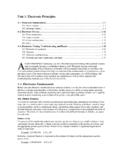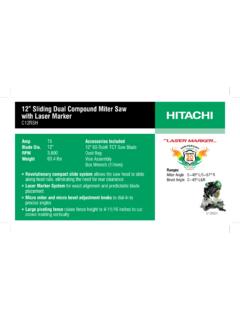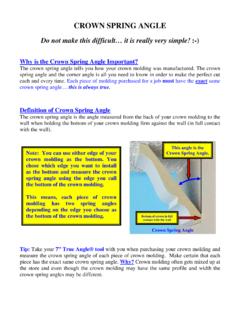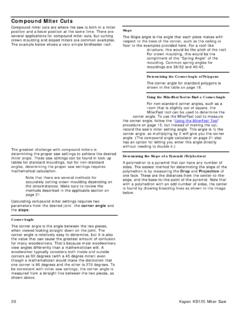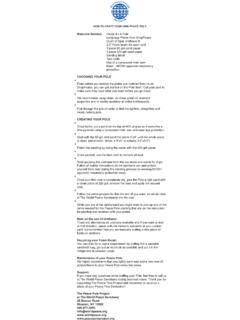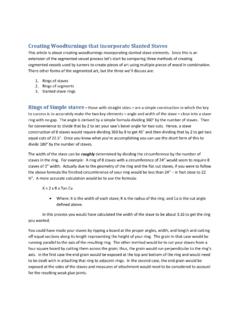Transcription of Composites Inspection and Repair - rcptv.com
1 Composites Inspection and RepairSteve Kane AdjunctBCC Aerospace TechnologyIn conjunction with SpaceTEC Topics Introduction Composites Review Characteristics Materials Fabrication Techniques Composites Safety Shop Safety Inspection Damage Identification Repair TechniquesOutline Introduction Composites Inspection and Repair Day 1 PowerPoint Lecture: Composites Characteristics, Materials, Fabrication Techniques, Composites Safety, Shop Safety, Inspection , Damage Identification, Repair Techniques Lunch Lab Project 1 composite Sandwich Construction Day 2 Review, Project Assessment Lab Project 2 Damage Inducement, Core Repair , Scarf Repair Technique Lunch Exam, Discussion, CertificateIntroduction Purpose.
2 Inspection and Repair Workshop Follow-on to Introduction to Composites Provide knowledge ofand a practical application forinspection of Composites and Repair of damages Intended to be advisoryin nature Repair data provided by OEM manufacturers, qualified engineers, and/or regulatory agencies must beconsulted in any Inspection and/or Repair methodComposites ReviewDefinition of Composites From Introduction to Composites : What are Composites ? Two or more materials working together Each contributes its own structural properties Each retains its unique identity Two major components: Reinforcing Fiber ceramic strong but brittle Matrix (glue) plastic tough yet flexibleHow They Work How do they work?
3 Individually: Fiber reinforcement strong, stiff, but brittle Matrix tough, elastic, but lacks rigidity Together = strength, stiffness and toughness, a superior material!!+=Types Three Basic Types: Natural occurs in nature Wood Artificial produced from naturally occurring materials to improve on natural Adobe Plywood Concrete Synthetic produced from artificial materials to improve on artificial Fiberglass Graphite (Carbon) Fiber Aramid (Kevlar) Specific Strength:Characteristics, cont. Specific Stiffness:Advantages, Advantages of Composites : Do not corrode Smooth surfaces relatively easy to achieve Many manufacturing methods available: Hand layup, Vacuum bagging, Resin Transfer Molding (RTM), Pultrusion, Filament winding, Resin infusion High strength/stiffness-to-weight ratios possible 4-10 times that of metals Structures can be tailored to meet specific applications Orienting fibers to carry specific loadsLimitations What are their limitations?
4 Fiber reinforcement prone to cracking Brittle nature means little or no elasticity Sudden failure at yield point Matrix mitigates brittleness Works as stop-drill would in aluminum Not much chance all cracks will line up Shear forces bog down Bicycle Analogy Solid ground moves freely Softer ground more resistanceDisadvantages Disadvantages: Labor intensive Special training needed Raw materials expensive Manufacturing equipment expensive Health and safety concerns for materials Cannot be recycled Little or no warning before failure Some materials may not be compatible with metals Galvanic Series Carbon (noble) and aluminum (active)Weave Patterns Plain Weave One over and one under every other yarn Provides fabric stability The least pliable, least strong weave Basket Weave Similar to plain but two warp yarns over and under More pliable and stronger than plain Crowfoot (Four-Harness Satin)
5 More pliable, easier to form on compound curves Three yarns over and one yarn under Five-Harness Satin (5HS) Similar to Crowfoot but one more filling yarn, 4 over and 1 under More pliable than crowfoot Eight-Harness Satin (8HS) Similar to 5-harness except one yarn floats over seven and under one Very pliable weave and has good drape Great for compound curve surfaces Most expensive weaveWeave PatternsWeave PatternsWeave Patterns Warp Direction Parallel to the Long direction of the roll Also defined as parallel to the selvage edge Fill Direction 90 degrees to the Warp direction Selvage edge to selvage edge Sometimes called Weft direction Selvage Edge Tightly woven edge to prevent edge raveling Parallel to warp threads Bias A 45 degree angle to the warp threads Fabric can be stretched along the bias but seldom along warpTextile TerminologyTextile
6 TerminologyTextile Terminology Advanced Composites are by design Orientation of fibers is proportional to properties The more fibers in a given direction, the stronger and stiffer Unidirectional (0) degrees for tension, compression, or bending Bidirectional (+/- 45 s) degrees for shear Control fiber angles +/- 2 degrees Sandwich Construction Enhances performance by placing the load carrying fibers on the outside of the partFiber Orientation Symmetry A laminate in which all of the ply orientations are symmetrical about the mid-plane of the laminateCommon Layup Terms Balance A Balanced laminate has equal numbers of + and angled pliesCommon Layup Terms Quasi-Isotropic A laminate laid up with an equal number of plies at 0 , +45 , -45 , and 90 anglesCommon Layup Terms Nesting vs.
7 Stacking Placing plies so the fibers of one ply align with the yarns of the adjacent ply Only possible with harness-satin weavesCommon Layup TermsShop Safety Working Environment: Good housekeeping directly impacts safety Keep area neat & orderly Properly dispose of mixing containers Keep fabric remnants swept up Wipe up spills, keep tools clean Do not block access to safety equipmentEnvironment Personal safety while sanding or drilling: Respirators must be worn Wear shop coat to minimize particles entering pores of skin Use eye protection Always shower at the end of the day after working with compositesPersonal SafetyShop Safety Compressed air in the shop area Moisture is your enemy!
8 Check moisture traps often Air Tools Flexible lines can take on a life of their own if unsecured Disconnect tools from air supply before changing cutters, sanding discs and drills Point the exhaust away from other people Never blow surfaces with compressed air! Causes projectiles Can cause delaminations Use a brush or vacuum for cleaning parts, machines, and work tables Tool Safety Use Eye Protection Safety glasses with side shields are a must Wear dust mask when cutting, drilling, sanding NIOSH-rated Cutting When Cutting: Keep hands, fingers away from cutting surfaces Razor Knives Very sharp, use cautionTool Safety Tool Safety, cont.
9 Drilling When Drilling: Back up materials Don t use your hands! Always know what is behind Never force drills! Will cause breakouts on other side Can disbond laminate-to-core interface Use high speed, low pressure Let the bit do the work!Tool Safety Tool Safety, cont. Sanding When Sanding: Wear eye protection/dust masks Work in a suitable area: Down-draft tables Exhaust systems Clean up debris: Clean up before tracking around Wash hands before eating or using the restroom!Tool SafetySandwich Structures Sandwich structures: Combination of strong, thin skins and a relatively light core material Very efficient structures with high stiffness-to-weight ratios Also called honeycomb Chief purpose of core: Passes shear forces between the skin surfaces Allows substantially improved structural properties in thicker sections with only slight increase in weightSandwich Structures Typical sandwich structures:Sandwich Structures Disadvantages of sandwich construction: Sandwich structures have thin skins that can be easily damaged by even minor impacts.
10 Susceptible to moisture intrusion: Can cause unintentional weight gain Freezing may cause disbonds (if subjected to lower temperatures of higher altitudes) If core becomes contaminated with oil, fuel or hydraulic fluid, it is virtually impossible to remove completely and must be replaced Honeycomb Form most commonly used in aerospace Made from Nomex (aramid paper), fiberglass, or aluminum Fire retardant, flexible and lightweight Offers best strength-to-weight ratio Cell shape Most common is hexagon, known as Hex Core Suitable for flat panels Difficult to curve Sandwich StructuresSandwich Structures Manufactured honeycomb core: Core direction is important.
